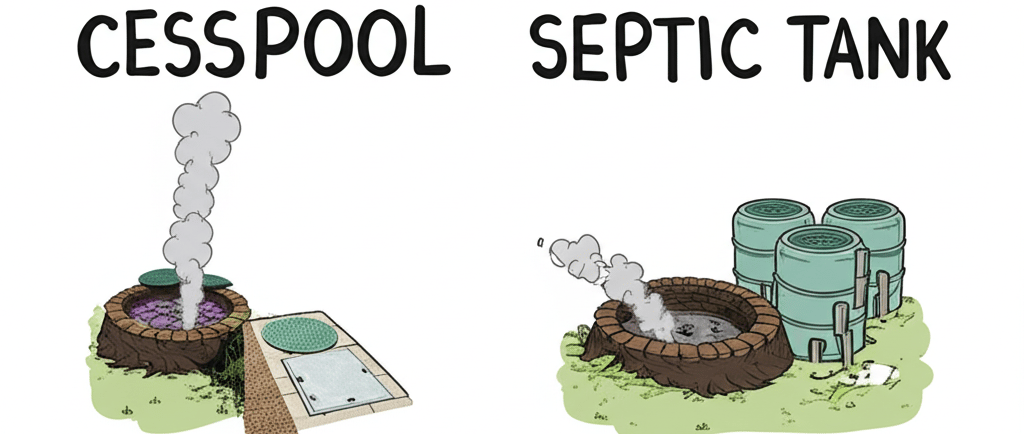Septic Tanks vs Cesspools
There is a distinct difference.
Thomas Brady
3/12/20252 min read


Septic Tanks vs. Cesspools: What Long Island Homeowners Need to Know 💧🏡
As a Long Island homeowner or potential buyer, understanding your property's waste management system is crucial for maintenance, budgeting, and environmental responsibility. While many newer homes connect to municipal sewer systems, a significant number of Long Island properties rely on septic tanks or cesspools. Let's explore the key differences between these systems and what they mean for you!
What is a Septic Tank? 🧪
A septic tank is a watertight chamber made of concrete, fiberglass, or polyethylene that receives and processes household wastewater. Here's how it works:
Wastewater flows from your home into the septic tank
Solid waste settles at the bottom (forming sludge) while oils and grease float to the top (forming scum)
Bacteria break down the waste naturally
Clarified wastewater flows out to a drain field where it's further filtered through soil
Septic tanks are designed as a two-chamber system that treats waste more thoroughly before releasing effluent into the environment.
What is a Cesspool? 🕳️
A cesspool (sometimes called a leaching pool) is a simpler, older system consisting of a single-chamber pit lined with concrete blocks or brick with perforated sides. Unlike septic tanks:
Cesspools collect wastewater in a single chamber
Liquid waste seeps through the perforated walls into surrounding soil
Solid waste collects at the bottom
There's minimal treatment before effluent enters the soil
Cesspools provide less treatment and filtration compared to septic systems.
Key Differences for Long Island Homeowners 📋
Environmental Impact 🌱
Septic tanks are significantly better for the environment, especially important on Long Island where groundwater protection is critical. Our sole-source aquifer system means contamination risks affect drinking water supplies.
Regulations and Compliance ⚖️
Suffolk and Nassau counties have increasingly strict regulations regarding waste management systems. Many areas now require septic tank installation when replacing old cesspools. Be aware that:
New construction typically requires septic systems
When selling, disclosure of your system type is mandatory
Some municipalities offer grants for upgrading from cesspools to septic systems
Maintenance Requirements 🔧
Septic Tanks:
Require pumping every 3-5 years
Professional inspection recommended annually
Better long-term performance with proper care
Cesspools:
Require more frequent pumping (typically every 2-3 years)
Higher likelihood of emergency issues
Shorter lifespan overall (20-30 years vs. 40+ years for septic tanks)
Property Value Considerations 💰
A property with a modern septic system typically has higher resale value than one with an aging cesspool. When house hunting, factor potential replacement costs into your budget if the property has an older cesspool.
What Long Island Homeowners Should Do Next 📝
Determine what system you currently have (check property records or schedule an inspection)
Research local regulations in your specific town/village regarding waste management systems
Consider the proximity to water bodies—properties near water may face stricter requirements
Budget for regular maintenance or potential system upgrades
Explore available rebate programs for system improvements through Suffolk or Nassau County
Final Thoughts 💭
As Long Island continues to address water quality concerns, understanding your waste management system becomes increasingly important. Septic tanks represent the more modern, environmentally friendly option, while cesspools are generally legacy systems that may require upgrading in the coming years.
Whether you're maintaining your current home or shopping for a new one, knowing the difference between these systems helps you make informed decisions about property maintenance, environmental responsibility, and long-term investment.
Remember that proper maintenance of either system is crucial—neglect can lead to costly repairs and potential environmental issues that affect not just your property, but our shared Long Island aquifer system! 💙
Vintage American Realty, LLC
Vintage American Realty, LLC is licensed in the State of New York
office: 631.319.4564
broker: 631.816.0719
info@vintageamericanrealty.com
1551 Montauk Hwy, Ste E
Oakdale, NY 11769
Long Island, NY


